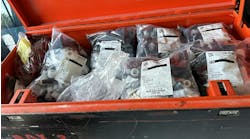Latest from Plumbing
Sponsored
Capturing and using heat that would otherwise go up the exhaust stack is an interesting idea anywhere. At McMurdo Station, Antarctica, recaptured energy (it is called “waste heat” here) is an important part of the heating system, and it is put to very good use.
McMurdo Station is a five hour plane ride from New Zealand, the nearest civilization. Everything — generating electricity, processing waste and creating fresh water — must be done on-site. These processes are all dependent upon the diesel jet fuel that is delivered by ship once a year. Providing for the needs of a thousand people requires a lot of energy, so getting the most out of the fuel is of particular interest.
Recapture of waste heat centers around the power plant where all of McMurdo's electricity is generated. Diesel generators produce 1,700kW of electricity. About one-third of that, or 550kW, goes up the exhaust stacks, one-third is given off by the generators' radiators, and one-third becomes electricity.
It is easy to see that there is a lot of opportunity to recover energy. The kilowatt number starts looking big when we translate it into heat. If we go back to basic science, we know that one watt = 3.412 Btus. So one kW = 3,412 Btus. And 550kW = 1,876,600 Btus. (Keep in mind that an ordinary North American home in the winter might be sized at 100,000 Btus.) Since that amount of energy is given off by both the stacks and the radiators, nearly 4 million Btus are available to be recovered.
The idea of using waste heat was first applied at McMurdo by the Navy in 1981 as an energy source for converting sea water to fresh water. Patterned after sea-going ships, the system used heat captured from the stacks of the power generators to boil salt water. The steam was then condensed into fresh water.
By 1995 the population of McMurdo had grown to where evaporation did not provide enough fresh water. Fresh water generation was converted to reverse osmosis, requiring much less energy. And strangely enough, it resulted in the stacks becoming an unuseable energy source because of inconsistent amounts of heat.
At about the same time, it became apparent that some of the station's heating boilers were significantly oversized. Besides the excessive use of energy, there was a problem with being able to control them. Like in North America, the boilers had been sized for the lowest imaginable temperature, which was in a completely different part of the continent, rather than design temperature. So the boilers were sized for -60°F when -20°F would have been more appropriate.
The new plan was to stop overheating and to save energy by using a combination of modular boilers and waste heat. Because computer control of widely-fluctuating waste heat temps was not available, designers chose to use the generators' radiators as a waste heat source. Unlike the stacks, they provide a constant amount of heat.
The design then became to use waste heat as the first stage of heat. This alone is sufficient throughout the summer (November - January). Modular boilers are brought online as the seasonal demands for heat increase.
The distribution of waste heat is done throughout the town with familiar primary-secondary piping, just like it is used in North American hydronic heating, using an equal mix of water and glycol. The primary loop consists of the power plant generator radiators, a pump and heat exchanger. Secondary loops service individual buildings.
Originally one building was heated this way. Now waste heats nine buildings down to 0°F outdoor temperatures. With the power plant upgrades that are currently in process, it is expected that waste heat will be sufficient down to -20°F.
The advent of direct digital computer control has also made it possible to get more out of waste heat. Direct digital control and outdoor reset can use the stack heat, which can run wild, as a heat source in addition to radiator heat.
Besides heating buildings, waste heat is also used at the water production plant to help make 55,000 gallons of fresh water a day. The only naturally-occurring water at McMurdo is the ocean — salt water.
Many years ago, fresh water was created by melting snow. Now the most effective method is to desalinate ocean water by running it though reverse osmosis filters. The mesh of the filters is smaller than salt molecules, but larger than water molecules. So when salt water is forced through the filters by considerable pressure, the salt is left behind.
The problem is that the ocean water at McMurdo is 26-28°F. It is liquid because of its salt content. Before desalinization, waste heat warms the sea water to 40°F. Waste heat is used for this process as well.
Carol Fey is a technical trainer and the author of books and a DVD on electricity, troubleshooting and controls. You can e-mail her at [email protected] or visit her website at www.carolfey.com. You can also visit her blog at: http://carolfey.blogspot.com.
Carol Fey
Carol Fey is a technical trainer and writer, specializing in easy electricity, hydronics and troubleshooting books. She also writes about HVAC work in Antarctica.

